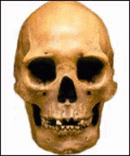



The human skulls are the oldest tested so far from the continent, and their shape is set to inflame further a controversy over native American burial rights.
The skulls were analysed by a scientist from John Moores University in Liverpool, UK, with help from teams in Oxford and Mexico itself.
They came from a collection of 27 skeletons of early humans kept at the National Museum of Anthropology in Mexico City.
These were originally discovered more than 100 years ago in the area surrounding the city.
'Amazing' find
The latest radiocarbon dating techniques allow dating to be carried out on tiny quantities of bone, although the process is expensive.
Dr Silvia Gonzalez, who dated the skulls, said: "The museum knew that the remains were of significant historical value but they hadn't been scientifically dated.
"I decided to analyse small bone samples from five skeletons using the latest carbon-dating techniques," she told BBC News Online.
"I think everybody was amazed at how old they were."
The earliest human remains tested prior to this had been dated at approximately 12,000 years ago.
Domestic tools dated at 14,500 years have been found in Chile - but with no associated human remains.
The latest dating is not only confirmation that humans were present in the Americas much earlier than 12,000 years ago, but also that they were not related to early native Americans.
Asian travellers
The two oldest skulls were "dolichocephalic" - that is, long and narrow-headed.
Other, more recent skulls were a different shape - short and broad, like those from native American remains.
This suggests that humans dispersed within Mexico in two distinct waves, and that a race of long and narrow-headed humans may have lived in North America prior to the American Indians.
Traditionally, American Indians were thought to have been the first to arrive on the continent, crossing from Asia on a land bridge.
Dr Gonzalez told BBC News Online: "We believe that the older race may have come from what is now Japan, via the Pacific islands and perhaps the California coast.
"Mexico appears to have been a crossroads for people spreading across the Americas.
"Our next project is to examine remains found in the Baha peninsula of California, and look at their DNA to see if they are related.
"But this discovery, although it is very significant, raises more questions than it solves."
Legal challenge
Scientific analysis of early skull finds in the US has often been halted by native American custom which assumes that any ancient remains involve their ancestors and must be handed over.
However, this evidence that another race may have pre-dated native Americans could strengthen legal challenges from researchers to force access to such remains.
Dr Gonzalez said: "My research could have implications for the ancient burial rights of North American Indians."
Dr Gonzalez has now been awarded a grant from the Mexican government and the UK's Natural Environment Research Council to continue her work for three years.
December 3, 2002
MORE (The Kennewick Man Case)
Dr Silvia Gonzalez, Liverpool John Moores University
